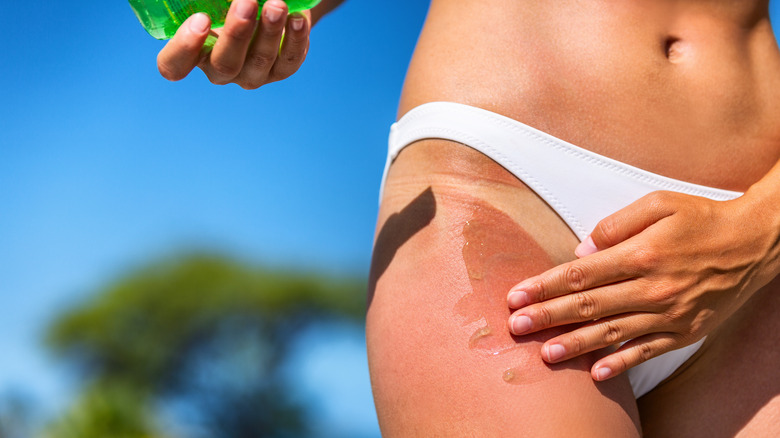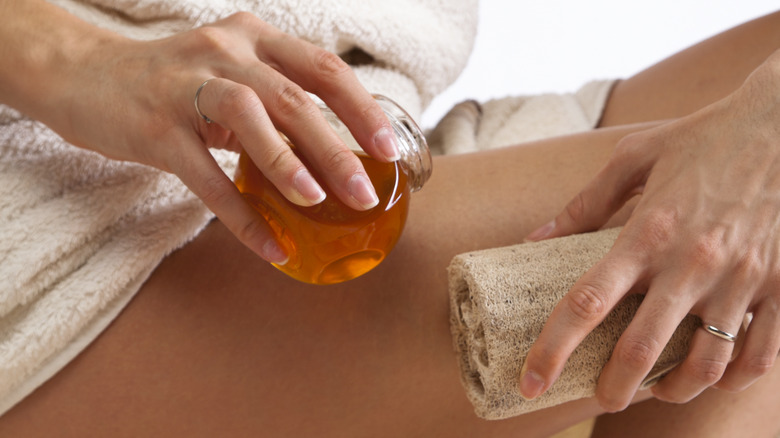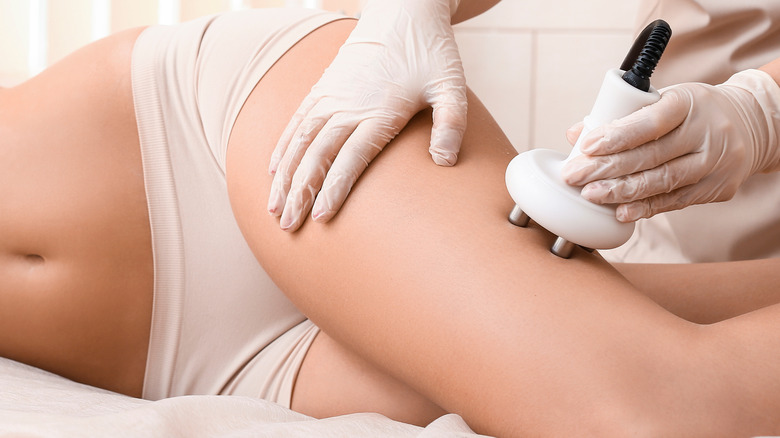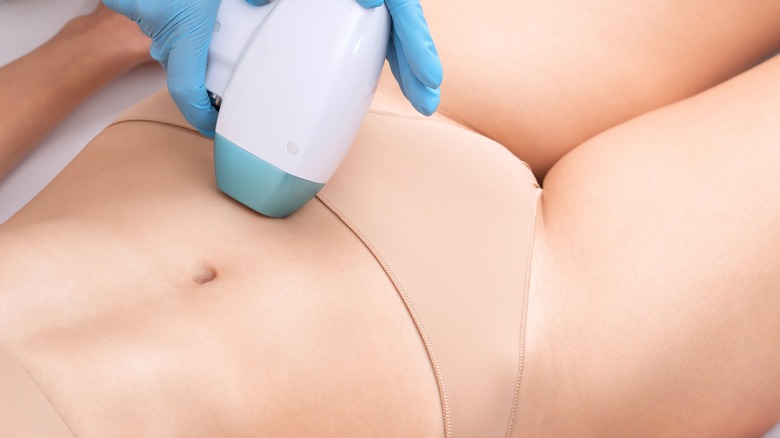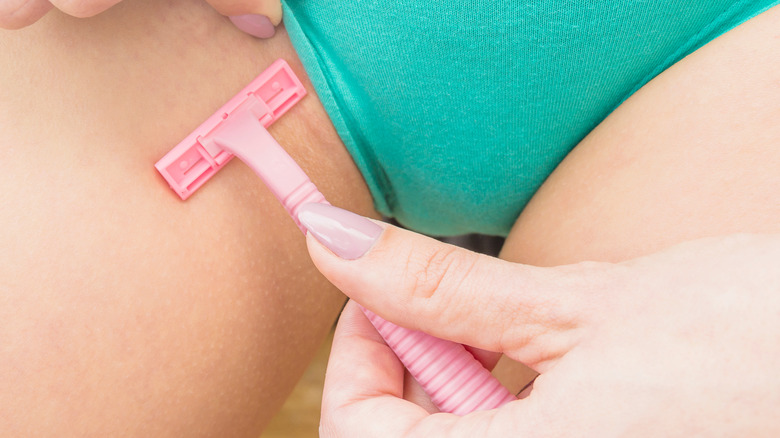Tips For Preventing & Treating Hyperpigmentation Along Your Bikini Line
When it comes to rocking a bikini, hyperpigmentation is probably the most common pet peeve after unwanted hair. Many people develop dark spots around their pubic area that sometimes spread further down their upper thighs. While hyperpigmentation along the panty line is most likely not a major cause for concern health-wise, it can cause discoloration in that area, making you feel self-conscious when wearing a swimsuit.
There are many reasons why your bikini line is breaking out in dark spots. It can be a result of the overproduction of melanin in the skin, hormonal imbalances, constant friction and chafing, and hair removal such as waxing or shaving, gynecologist Dr. Ruth Arumala tells Bushbalm.
Technically speaking, hyperpigmentation along the bikini line can develop just as a result of you going about life. But the good news is: It's not entirely impossible to rock a bikini sans unwanted hair and pigmented spots. There are home remedies and in-office treatments that can restore you to an even skin tone in your secluded area. Check out our best tips for how to lighten the dark spots along your bikini line and to prevent them from developing in the first place.
Apply a skin-brightening topical product
You can use topical treatments to get rid of dark spots along your bikini line. According to Vivant Skincare, products that quicken the process of cell turnover to replace old skin with new skin can aid in fading surface-level skin pigmentation and making the skin look lighter. For example, vitamin A derivatives, such as retinol, mandelic acid, lactic acid, and glycolic acid, are effective options for brightening the bikini line.
To amplify the lightening effect, you can pair these ingredients with other powerhouse brighteners such as vitamin C, kojic acid, or hydroquinone. Or you can use dark spot correctors or lightening serums specifically designed to reduce hyperpigmentation. If your dark spots are new, you can try fading them at home. For instance, you can apply a mixture of yogurt and gram flour to the area that needs lightening like a skin mask. Gram flour, a natural exfoliator, helps to even out the skin tone, while the lactic acid in yogurt acts as a natural bleaching agent to erase pigmentation. Lemon juice, with a high citric acid content, also makes an ideal choice for a DIY skin-lightening remedy.
Topical therapies typically take a longer time to produce results. To determine the precise cause of the uneven skin tone along your bikini line, consult a dermatologist for expert evaluation and treatment recommendations.
Exfoliate the darkened area
If your dark spots are new, maybe exfoliating them can help. Hyperpigmentation or discoloration is a result of an overproduction of melanin. By dissolving the pigmented cells and sloughing them off, exfoliation aids in reducing the excess melanin. The body's normal cell renewal cycle takes about thirty days, during which new cells are produced, multiply, crop up the skin's surface, and peel off over time. That process slows down as we age, allowing pigment to build up. Regular exfoliation accelerates cell turnover and aids in the shedding of extra pigment to reveal a new layer of skin.
The skin in the pubic area is sensitive. Chemical exfoliation, which can potentially disturb the pH balance and cause irritation, is not recommended. Physical exfoliators are a better option for your intimate skin, per Oyo Skincare. The best time to exfoliate your pubic skin is right before shaving.
To exfoliate, gently scrub the exfoliator against the vulva skin in a circular motion. While exfoliating, keep away from the vaginal opening. After leaving the product on for four to five minutes, rinse it off with warm water and pat it dry with a clean towel. Then, apply a moisturizing lotion to the exfoliated area to soothe the skin and minimize irritation.
Try a Dermamelan peel
Using a Dermamelan peel is an effective way to get rid of hyperpigmentation in the long run. A Dermamelan peel is a type of non-invasive treatment intended to treat pigmentation issues including sun damage, post-inflammatory hyperpigmentation, and melasma or chloasma. While this depigmentation method is commonly used in the facial area, it can also be used to remedy hyperpigmentation in the intimate area, such as the genital-perineal area, the pubic area, the perianal area, inner thighs, groin, and buttocks, per Dr. Michele Green, MD.
Dermamelan peels are beneficial for all skin types and are frequently suggested for people who have serious pigmentation problems. Usually, only one Dermamelan session, which lasts about 45 minutes, is required. Although there may be some minor swelling in the treated area for five to seven days after the procedure, it's mostly painless. Results should be visible three months following treatment.
Although Dermamelan can improve your condition significantly, you're not entirely out of the woods just yet. You'll have to take measures to prevent your condition from worsening, such as wearing loose clothing, avoiding abrasive hair removal methods, and keeping the treated area well-moisturized.
Laser treatment or microdermabrasion might help
If you're looking for the fastest way to improve hyperpigmentation along your bikini line, laser treatments for lightening darker skin are probably your best bet. As part of a laser therapy, the affected area is often exposed to controlled laser energy to help remove damaged skin cells and promote the growth of new skin cells. Laser treatment usually requires multiple sessions before you can start seeing results. Of course, not everyone is a prime candidate for laser treatment. It is important to speak to a dermatologist or cosmetic gynecologist for an accurate diagnosis of your condition before undergoing such a procedure.
Those suffering from uneven skin tone along the bikini line can also benefit from several sessions of microdermabrasion, a cosmetic procedure that buffs away dead skin cells using microscopic crystals and suction. By sloughing off the outermost or epidermal layer of the skin, microdermabrasion helps brighten the complexion in addition to reducing ingrown hair. Overall, it is an effective treatment for mild hyperpigmentation and melasma, but it works best when coupled with other techniques such as chemical peels and lasers.
Step up your shaving game
Grazing abrasive blades on your skin's surface can irritate your hair follicles and put your skin at risk of post-inflammatory hyperpigmentation. To prevent dark spots and ingrown hairs from cropping up on your panty line, learn to shave with care. If your pubic hair is on the longer side, Gillette Venus advises cutting it first with a bikini trimmer, an electric shaver, or a pair of scissors, and using a woman's razor for the shaving process. A dull razor blade can increase the risk of skin irritation. To ensure a smooth shaving experience, change your blade regularly. A razor blade can last five to ten shaves before you need to replace it, depending on how often you shave.
To hydrate your skin and soften your hair, spend at least five minutes soaking your bikini line in warm water, if possible. Then, gently rub a physical scrub along your bikini line to eliminate dead skin cells and loosen your hair, allowing for a smoother shave.
Before shaving, lather up some shaving gel to curtail risks of razor burn and irritation and reapply throughout your shave. When shaving, use steady strokes and shave in the direction of the hair growth. Once you're done, rinse off the shaved skin, pat it dry, and moisturize it with some soothing lotion or oil to keep your skin hydrated and ward off irritation.
Avoid tight clothing
The skin around your vulva is quite delicate and prone to irritation. Therefore, you should avoid wearing tight bottom garments and underwear whenever possible, as constant friction and pressure can irritate the skin and lead to hyperpigmentation.
Nylon and spandex, two synthetic fabrics that trap heat and moisture, are also poor choices for underwear fabric. If worn for an extended period of time, they may cause chafing and yeast infection. Wearing super tight shapewear for a long time can also be problematic for your skin.
Tight clothes cause more than just skin irritation and discoloration. It might constrict blood circulation and make you feel uncomfortable throughout the day. "You're slowing the free motion of the gastrointestinal system and trapping the gas inside," hepatologist Dr. Wakim-Fleming tells Cleveland Clinic. If you're struggling with redness and discomfort in your pubic area and inner thighs, take a break from tight garments and stick to well-fitting garments made from cotton or linen.
Try out a long-term hair removal method
Since abrasive hair removal methods, such as waxing and shaving, are the main culprits behind your dark bikini area, using a more long-term method like laser hair removal can help improve your condition in the long run. Not only can it remedy pigmentation-related issues, but it can also prevent common shaving-induced irritations, such as razor burns, red bumps, and ingrown hair.
Laser treatments, which safely damage hair follicles, can reduce hair growth in the treated area, making regrown hair much finer and less noticeable. This procedure can provide you lasting results while saving you time and effort spent shaving and waxing your skin raw. The main drawback to laser treatment is that it must be repeated on a frequent basis to prevent hair regrowth.
Depending on each person's condition, some might require six sessions to achieve desired results, while others can achieve similar results with fewer. For instance, hormonal imbalances experienced during pregnancy or menopause might cause hair to regrow more quickly.
Amp up SPF around the bikini line
Prolonged unprotected exposure to glaring UV rays or tanning beds predisposes your skin to pigmentation issues. UVB rays can penetrate the skin and damage the DNA within living skin cells, leading to sunspots and premature aging. Slathering up with a sunblock with an SPF 30 or higher from head to toe before wearing your swimsuit into the sun is crucial for protecting your skin from sunburns and pigmentation.
Your pubic area and the shoulder skin under your bra straps are some sun-exposed spots that you tend to overlook, so take care to apply SPF liberally to these areas before heading out.
Another way to spare your bikini line the brunt of hyperpigmentation is to wear a lightweight cover-up over your bathing suit. It can be a caftan, a sarong, or any loose-fitting garment that lends your bikini line skin additional protection from the sun. When you're not swimming, keep your cover-up on and seek shade to curtail the intensity of UV rays on your skin.
